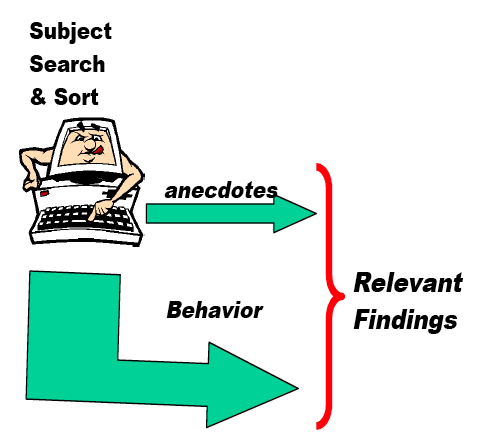
what (do we do)
who (can benefit)
why (are we needed)
how (do we work)
where (do we do our tasks)
when (are we needed)
feedback (from previous clients)
Each investigation starts by building a framework of questions describing what we want to know. In addition to typical questions around market size we might want to know the answers to:
![]() • What are the boundaries of the industry?
• What are the boundaries of the industry?
![]() • Who participates? Who influences? Who regulates?
• Who participates? Who influences? Who regulates?
![]() • What is the relationship to other industries?
• What is the relationship to other industries?
![]() • What is the time frame we are interested in?
• What is the time frame we are interested in?
![]() These questions help us understand who to include in our investigation. We then plan the actual dialog of investigating interviews.
These questions help us understand who to include in our investigation. We then plan the actual dialog of investigating interviews.
![]() Each investigation has two data collection strategies. Qualitative data is discovered through interviews of participants in the market. Quantitative data is found primarily by analyzing public databases. Interviews are conducted over a spectrum of stakeholders in the industry. While not of statistical validity, these interviews signal issues of significance in the industry. We are mindful to select stakeholders having varied profiles to ensure an industry wide view.
Each investigation has two data collection strategies. Qualitative data is discovered through interviews of participants in the market. Quantitative data is found primarily by analyzing public databases. Interviews are conducted over a spectrum of stakeholders in the industry. While not of statistical validity, these interviews signal issues of significance in the industry. We are mindful to select stakeholders having varied profiles to ensure an industry wide view.
![]()
 The interviews are conducted with open-ended questions using “appreciative inquiry” techniques to encourage story telling and positively reinforce the interview experience. Stories are an important element of the interviews as a way release emotions around experiences. Stories also reveal dreams and visions of those being interviewed. Interview data is recorded literally in a first person context in order to maintain objectivity.
The interviews are conducted with open-ended questions using “appreciative inquiry” techniques to encourage story telling and positively reinforce the interview experience. Stories are an important element of the interviews as a way release emotions around experiences. Stories also reveal dreams and visions of those being interviewed. Interview data is recorded literally in a first person context in order to maintain objectivity.
![]() Sources of databases of interest to the
Sources of databases of interest to the investigation include Government agencies, almanacs, industry interest groups, news groups, expert groups, and annual reports. Two questions help filter the data. Why do we care? And, how does this data help us build a better model of the market? Frequently, issues and responses from the interview data will point to sources of data. The interview data also compliments the data base research by providing anecdotal references to validate research findings.
investigation include Government agencies, almanacs, industry interest groups, news groups, expert groups, and annual reports. Two questions help filter the data. Why do we care? And, how does this data help us build a better model of the market? Frequently, issues and responses from the interview data will point to sources of data. The interview data also compliments the data base research by providing anecdotal references to validate research findings.
![]() Once the data is collected, data mining can begin. Creating Alternatives has devised techniques for using computer tools to scan large volumes of verbal data for significance and topical correlation. These tools assist in the search for common themes, for similarities and differences and for contradictions in the data. Anecdotal data gets special attention as an assist in to the data base research.
Once the data is collected, data mining can begin. Creating Alternatives has devised techniques for using computer tools to scan large volumes of verbal data for significance and topical correlation. These tools assist in the search for common themes, for similarities and differences and for contradictions in the data. Anecdotal data gets special attention as an assist in to the data base research.
![]() Conclusions drawn from the data are given three tests.
Conclusions drawn from the data are given three tests.

![]() • So, What? Does this conclusion have any real bearing on the research being conducted?
• So, What? Does this conclusion have any real bearing on the research being conducted?
![]() • Does this conclusion make sense to the head and the heart? If either element is missing it may mean that this conclusion has little if any significance.
• Does this conclusion make sense to the head and the heart? If either element is missing it may mean that this conclusion has little if any significance.
![]() • What is the confidence in this conclusion? In other words is there a high probability that additional investigation would reinforce this conclusion.
• What is the confidence in this conclusion? In other words is there a high probability that additional investigation would reinforce this conclusion.
![]() The whole process comes together in a final report. As an independent consultant, Creating Alternatives stresses the objectivity of the investigation and the final report. However, preparation of this final document provides an im
The whole process comes together in a final report. As an independent consultant, Creating Alternatives stresses the objectivity of the investigation and the final report. However, preparation of this final document provides an im portant opportunity to think about alternative approaches for the market in question. Frequently, new targets are uncovered, new distribution schemes become clear, or different means of favorably changing the regulatory landscape come to mind. Creating Alternatives will include these possibilities in the final document.
portant opportunity to think about alternative approaches for the market in question. Frequently, new targets are uncovered, new distribution schemes become clear, or different means of favorably changing the regulatory landscape come to mind. Creating Alternatives will include these possibilities in the final document.
![]()
